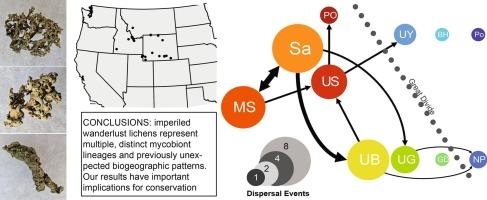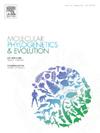Imperiled wanderlust lichens in steppe habitats of western North America comprise geographically structured mycobiont lineages and a reversal to sexual reproduction within this asexual clade
IF 3.6
1区 生物学
Q2 BIOCHEMISTRY & MOLECULAR BIOLOGY
引用次数: 0
Abstract
The northern North American Cordillera is a globally significant center of endemism. In western North America, imperiled arid steppe habitats support a number of unique species, including several endemic lichens. However, processes driving diversification and endemism in this region remain unclear. In this study, we investigate diversity and phylogeography of the threatened wanderlust lichens (mycobiont = Rhizoplaca species) which occur unattached on calcareous soils in steppe habitats. Wanderlust lichens comprise three species of lichen-forming fungi (LFF) – Rhizoplaca arbuscula, R. haydenii, and R. idahoensis (endangered, IUCN Red List) – which occur in fragmented populations in Idaho and Wyoming, with more limited populations in southern Montana and northern Utah. These lichens reproduce almost exclusively via large, asexual vegetative propagules. Here, our aims were to (i) assess the evolutionary origin of this group and identify phylogeographic structure, (ii) infer ancestral geographic distributions for lineages within this clade, and (iii) use species distribution modeling to better understand the distribution of contemporary populations. Using a genome-skimming approach, we generated a 19.1Mb alignment, spanning ca. half of the complete LFF genome, from specimens collected throughout the entire range of wanderlust lichens. Based on this phylogeny, we investigated phylogeographic patterns using RASP. Finally, we used MaxEnt to estimate species distribution models for R. arbuscula and R. haydenii. We inferred a highly structured topology, with clades corresponding to distinct geographic regions and morphologies collected throughout the group’s distribution. We found that R. robusta, a sexually reproducing taxon, is clearly nested within the vagrant Rhizoplaca clade. Phylogeographic analyses suggest that both dispersal and vicariance played significant roles throughout the evolutionary history of the vagrant Rhizoplaca clade, with most of the dispersal events originating from the Salmon Basin in eastern Idaho – the center of diversity for this group. Despite the fact that wanderlust lichens are dispersal limited due to large, unspecialized vegetative propagules, we inferred multiple dispersal events crossing the Continental Divide. Comparing herbarium records with species distribution models suggests that wanderlust lichens don’t fully occupy the areas of highest distribution probability. In fact, documented records often occur in areas predicted to be only marginally suitable. These data suggest a potential mismatch between contemporary habitats outside of the center of diversity in eastern Idaho with the most suitable habitat, adding to the vulnerability of this imperiled complex of endemic lichens.

北美西部干草原栖息地的濒临灭绝的流浪地衣由地理结构上的分生孢子系和这一无性生殖支系中的有性生殖逆转组成。
北美科迪勒拉山系北部是全球重要的特有物种中心。在北美洲西部,濒临灭绝的干旱草原栖息地孕育着许多独特的物种,其中包括几种特有的地衣。然而,该地区地衣多样性和特有性的驱动过程仍不清楚。在这项研究中,我们调查了北美西部干草原栖息地钙质土壤上未附着的濒危游走地衣(mycobiont = Rhizoplaca species)的多样性和系统地理学。漫游地衣包括三种地衣形成真菌(LFF)--Rhizoplaca arbuscula、R. haydenii 和 R. idahoensis(濒危,世界自然保护联盟红色名录)--它们在爱达荷州和怀俄明州的种群零散分布,在蒙大拿州东南部和犹他州北部的种群更为有限。这些地衣几乎只通过大型无性繁殖体进行繁殖。在这里,我们的目标是:(i) 评估该类地衣的进化起源并确定系统地理结构;(ii) 推断该支系中各系的祖先地理分布;(iii) 利用物种分布模型更好地了解当代种群的分布。利用基因组筛选方法,我们从整个流浪地衣分布区采集的标本中生成了 19.1 Mb 的比对结果,约占流浪地衣完整基因组的一半。在此系统发生的基础上,我们使用 RASP 研究了系统地理学模式。最后,我们使用 MaxEnt 估算了 arbuscula 和 haydenii 的物种分布模型。我们推断出了一个高度结构化的拓扑结构,其支系对应于不同的地理区域,形态则代表了整个类群的分布。我们发现,R. robusta(一个有性繁殖的类群)明显嵌套在这一无性系中。系统地理学分析表明,在流浪地衣类群的进化史上,散布和沧海桑田都发挥了重要作用,其中大多数散布事件都源自该类群的多样性中心--爱达荷州东部的鲑鱼盆地。尽管流浪地衣由于无性繁殖体大而扩散受限,但我们还是推断出了多次跨越大陆分水岭的扩散事件。比较标本馆记录和 SDMs 表明,游走地衣并没有完全占据分布概率最高的地区。事实上,有记录的地衣经常出现在预测为非常适合分布的地区。这些数据表明,爱达荷州东部多样性中心以外的当代栖息地可能与最适合的栖息地不匹配,从而加剧了这一濒临灭绝的特有地衣群的脆弱性。
本文章由计算机程序翻译,如有差异,请以英文原文为准。
求助全文
约1分钟内获得全文
求助全文
来源期刊
CiteScore
7.50
自引率
7.30%
发文量
249
审稿时长
7.5 months
期刊介绍:
Molecular Phylogenetics and Evolution is dedicated to bringing Darwin''s dream within grasp - to "have fairly true genealogical trees of each great kingdom of Nature." The journal provides a forum for molecular studies that advance our understanding of phylogeny and evolution, further the development of phylogenetically more accurate taxonomic classifications, and ultimately bring a unified classification for all the ramifying lines of life. Phylogeographic studies will be considered for publication if they offer EXCEPTIONAL theoretical or empirical advances.

 求助内容:
求助内容: 应助结果提醒方式:
应助结果提醒方式:


